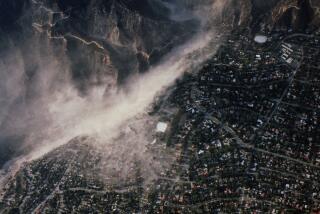Quake Scientists Hopeful About Drilling Project on San Andreas
PARKFIELD, Calif. — Scientists from Stanford University and the U.S. Geological Survey say they have calculated the ideal place to drill a 1.4-mile-deep research hole along California’s San Andreas fault.
“We are in a transitional zone of the fault,” Stanford geophysicist Mark Zoback told reporters gathered Monday from throughout the state. “The magnitude-6 earthquake of 1857 ruptured south from here. It probably was a foreshock of the great magnitude-8 Fort Tejon earthquake of that same year.”
For the record:
12:00 a.m. July 3, 2002 For The Record
Los Angeles Times Wednesday July 03, 2002 Home Edition Main News Part A Page 2 ..CF: Y 10 inches; 361 words Type of Material: Correction
Drilling site--A photograph in Tuesday’s California section showing a U.S. Geological Survey tour near Parkfield misstated the locale. The site shown was a monitoring station along the San Andreas fault near Parkfield, not the current San Andreas drilling site, which is eight miles to the north.
*
To the north of this site, “the fault is creeping in a fairly constant movement,” he said, “And right here is the transitional zone with a spate of tiny quakes, magnitude-2s, occurring every year and a half or so. So we are assured of having something to study, even if the magnitude-6 earthquake we expect doesn’t come soon.”
The $1.5-million drilling project is being financed by a nine-nation consortium headquartered in Germany. The scientists hope Congress will appropriate $30 million to make it the forerunner of a hole 2.4 miles deep that actually will cross the fault at that depth. The Bush administration has asked for that money.
The drilling of the first hole, 8.5 inches wide at its farthest depth, has been going on for three weeks at an average of seven feet an hour.
There are a few delays in the round-the-clock drilling so methane and other gases can be measured. By noon Monday, the drill had reached 3,985 feet.
The hole should be completed by the end of the month. Then instruments will be lowered into the pipe-encased hole, and years of research into earthquake processes will begin.
Scientists say they are certain their experiment will not trigger an earthquake, but say it will record them with unprecedented precision.
The scientists gathered here were at pains to emphasize the limits of their experiment. It will not, said the U.S. Geological Survey’s Stephen Hickman, allow anyone to precisely predict the next magnitude-6 earthquake. But they hope to learn much more about what causes a quake to begin, and perhaps more about what dictates its magnitude.
The drill holes will not be deep enough to allow a direct look at a big quake, because these usually begin five to seven miles deep. It would cost $150 million to drill a hole that deep, and scientists don’t think that kind of funding will be available any time soon.
But the instruments in this hole will allow a direct look at clusters of small quakes nearer the surface and, it is hoped, reveal the “influences” of the deeper, bigger quakes on the fault close to the surface.
One theory the scientists hope to test is that fluids are rising from the lower part of Earth’s crust and the upper reaches of its mantle, perhaps 20 miles down, somehow triggering quakes. Scientists will measure fluid pressure and compare it with the timing of small quakes.
“Unlike our surface explorations, we’re going to be right in the fault zone with our instruments, much better linked to the quake process,” he said.
Quake scientists have been in the Parkfield area, 190 miles north of Los Angeles, for nearly 20 years, mainly because records show that beginning in 1857, six earthquakes of magnitude 6 were centered near here, occurring on average every 22 years.
Based on this, in 1985 they predicted a 95% likelihood of another occurring by the end of 1993. That hasn’t happened.
John Langbein, the USGS scientist in charge of Parkfield research on the surface, said Monday that he has $2 million worth of instruments waiting to record the big quake. One of them, a $200,000 Electronic Distance Meter, can measure the movement of the earth at that moment within one millimeter.
Scientists hope the instruments implanted in the drill hole will be help them explain why it moved and how.






